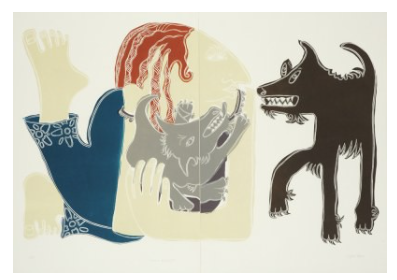

Precipice, is one of two exhibitions curated by Hannah Draper, as part of our Early Career Curator Programme – an opportunity to research and develop a series of exhibitions.
The exhibition features five artworks from our collection:
Elspeth Lamb, Green Tea and Fuji-San, 2017
George Todd, The Edge of the Forest, 1994
Helen Chadwick, Anatoli III, 1993
Jane Miller, Womens Best Friend, 1993
John Bellany, Madonna of the Bass Rock, 1997
Woman looks at dog, woman is licked by dog, woman looks out to sea, someone stares out of the window at a mountain, mountain looks back at you, baby looks at you, you look back, forest beckons you, cells within you enlarged, cells you can’t see, dog looks at you – you look back.
This vibrant collection of works explores the boundaries between the mundane and the spectacular, the microbial and the mountainous and the human and other than human (animal, cell, land, sea). We are transported from specific sites such as the Bass Rock off the coast of North Berwick, as well as mythical entrances to forest with green glass bottles the size of trees. Where one meets an other, edges are blurred, and the borders between mystery and realism become less defined.
Anatoli III depicts a cell like form amidst a swirling liquid, or marble-esque, background. Along the bottom edge of the image a rock like form juts out, a precipice over which we look. The result is a destabilising dizziness as if we are looking over a cliff edge from above. The yellow cell is the central part of the image and its disproportionate scale draws further attention to it.
Similarly, Madonna of the Bass Rock uses an unusual depiction of space – showing the Madonna looking outwards, with the Bass Rock floating above her head. We are shown what she is looking out at. Just as the Madonna embraces her child, so does the woman in Woman’s Best Friend embrace a dog who licks her face, while another dog stands close by, ready to play with his paw raised. The saturated hues in Bellany’s painting, and the intimacy between the woman and dog in Miller’s work add to the feeling of surrealness and even of abjection – we might be unsure how to feel when we first see these works.
In Green Tea and Fuji-San our view is distorted in a different way by the collaged and tilting frames of the window through which we see Mount Fuji. The seeping ink of the mountain gives it a feeling of aliveness and movement in contrast to the static and thick lines of the window frame which keep separate us from it. In George Todd’s Edge of the Forest we are also on the edge of an unknown space. While a house hides on the left side, tall trees reach to the edge of the frame. The child-like cropped framing of the edge on the sky and the floating clouds adds to the surrealness of the image, compounded by the bottle the size of a tall tree, or a two floor house, and the red and white abstract trees stood beside it.
In all these artworks, we stand at the edge of a forest, of a window, a cliff, the shore – between one body and another, between different mediums. This border to another place is presented as a possibility to become acquainted with the unknown. While using embodied viewing to initially interact and approach with these artworks, I was intrigued how these works blurred the boundary of the body and how their surreal and mystical elements of representation and story-telling in these works may provide respite, escapism and intrigue for the viewer.
The Early Career Curator Programme was supported by Museum and Galleries Scotland.
22 May 2023 by
Amy Miles